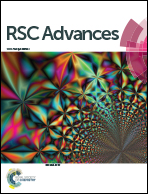Self-assembly of silicon/carbon hybrids and natural graphite as anode materials for lithium-ion batteries†
Abstract
Silicon/carbon/natural graphite (Si–C–NG) composites have been successfully prepared by the granulation of natural graphite (NG) and silicon/poly(acrylonitrile-co-divinylbenzene) [Si/poly(AN-co-DVB)] hybrid microspheres via spray drying and subsequent pyrolysis. The poly(AN-co-DVB) microspheres containing silicon nano-flakes are synthesized by microsuspension polymerization using benzoyl peroxide (BPO) as initiator and polyvinyl alcohol (PVA) as dispersant in aqueous phase. The morphology and microstructure of Si–C–NG composites are characterized by scanning electron microscopy (SEM), transmission electron microscopy (TEM), energy dispersive spectroscopy (EDS), X-ray diffraction (XRD) and Raman spectroscopy. It is found that the Si nanoparticles are uniformly enwrapped by pyrolytic carbon derived from poly(AN-co-DVB) to form Si–C core/shell structures, which are subsequently decorated on the surface of NG, resulting in a spherical Si–C–NG structure. When used as anode materials for lithium-ion batteries, the Si–C–NG composites exhibit a high specific capacity of 471.5 mA h g−1, a high initial coulombic efficiency of 78.4%, and a good cycling stability with capacity retention of 87.9% after 100 cycles at a current density of 100 mA g−1.


 Please wait while we load your content...
Please wait while we load your content...